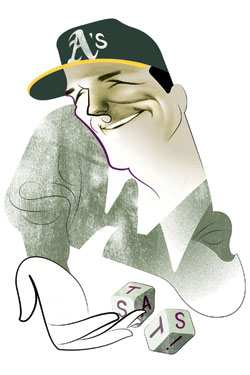
Moneyball made it look so easy. That the Oakland A’s now reside at the bottom of the American League West, after yet another mid-season capitulation trade, suggests otherwise. It’s hard. It’s very hard.
Michael Lewis’s 2003 best seller about A’s general manager Billy Beane was a smash because it wasn’t just about baseball. It was a self-help book. It told the story of a man who saw value that others did not see, who zigged when other men zagged, who left conventional leaders behind. Billy Beane was not merely the general manager of a small-market baseball club: He was a captain of industry, an American pioneer, a Warren Buffett oracle. Moneyball became another Tipping Point, a book about quixotic leadership techniques that could be hashed over at corporate seminars, a Ten Secrets of Successful Managers: This Could Be You, And Here’s How.
Beane was an enthralling central character, a failed major leaguer to whom Lewis lent enough defiant flavor that of course Brad Pitt wanted to play him in the movie. The book shook baseball to its core, starting a stathead-versus-scout culture war that still rages and made Beane a target for his peers. Lewis might have seen Beane as an American original, but much of the rest of baseball, in the wake of the book’s massive success, considered him an uppity prick who talked a good game but had never actually won anything.
Beane, however, didn’t want to be an entrepreneurial icon; he just wanted to win a World Series, or at least get there. The book, amusingly enough, helped assure that that would never happen.
Moneyball is fundamentally about how market inefficiencies can be identified and exploited, which explains why the business world took notice. The A’s didn’t have the payroll of the Yankees or the Red Sox or the Cubs, so they had to be smarter. When Moneyball was written, the big-money teams didn’t know about—or at least didn’t recognize the importance of—“sabermetric” stats like DIPS, LIPS, PERA, and EqA. (These are real stats, and enlightening ones, no matter how much ESPN commentator Joe Morgan, a notorious flat-Earther, mocks them) The book changed that. Pretty much every team got religion. Boston’s GM, Theo Epstein, and our own Brian Cashman (to a lesser extent) are steeped in the principles of sabermetrics. The A’s aren’t sneaking up on anyone anymore.
Well, almost anyone. Two years ago, in a Sports Illustrated cover story called “Mix Master,” Mets general manager Omar Minaya boasted that his success came from ignoring sabermetrics, which he called “paperwork.” “Look, if you want paperwork, I’m not your guy,” Minaya told SI’s Gary Smith. “I see the job in bigger terms. Paperwork, that’s false hustle. It takes away creativity.”
If every general manager in baseball thought like Minaya, Beane would still be in top form; as it is, he had to forage for newer, more elusive inefficiencies. Defense was popular for a while; Beane relied on novel measures like “range factor,” which tracks how many balls fielders are able to get to. But the rest of baseball aped him faster than last time; one reason for the Rays’ success last year was their vastly improved infield defense. It has also done wonders for the Rangers this year.
So now Beane has come full circle, forced to play hunches: Among his recent strategies is the Aging Slugger Gambit. Last year, he signed 39-year-old Frank Thomas. This year, it was Jason Giambi, neglected by other teams in a (theoretically) post-steroid era. In another sign of Beane’s weakening principles, the Giambi signing had a sentimental component, too; his best seasons were with the A’s.
Beane hoped to wring one last bit of offensive value from these fading stars, and, like most baseball snap judgments, it hasn’t worked; the A’s are in the midst of their third straight losing season. So Beane punted, trading a young star, Matt Holliday, for even younger prospects, just like he did with Dan Haren, Rich Harden, and many more. Beane has gone from a visionary to a man who is constantly constructing a future that never comes.
Steven Soderbergh, slated to direct the film until he was kicked off the project, might have imagined Moneyball as a tale of plucky underdogs rising to defeat monolithic Big Enterprise (read the Yankees), with Cool Guy Brad Pitt assisted by Über-Nerd Demetri Martin in building a backroom Bad News Bears. But baseball doesn’t work that way, not anymore. Once the Yankees and the Red Sox learned Beane’s tricks—something they were on their way toward doing before Moneyball ever came out—they applied them with three to four times the payroll. Moneyball made an inefficient marketplace more efficient, and in the process drove Beane into the second division. The loophole has been closed, and Beane is in danger of losing his Golden Boy status. To save his legacy, he must do something dramatic.
I have an idea for him. It would require some, um, paperwork.
When Omar Minaya petulantly called out Daily News beat writer Adam Rubin at the press conference about the firing of team official Tony Bernazard last week, a widely held suspicion about the Mets became concrete: They are falling apart on the field and off. (Minaya, who preposterously accused Rubin of breaking the story about Bernazard’s misconduct because Rubin wanted a player personnel job, was chastised by Mets chief operating officer Jeff Wilpon and later apologized.) Minaya signed an extension with the Mets just ten months ago, but since then, well, we all know what’s happened. This season has been a disaster. Yes, injuries have been devastating, and there’s not much anybody can do about that. But the Mets so lacked depth that they’ve had to put ancient castoff Fernando Tatis in the cleanup spot. And there was never any excuse for the contracts Minaya lavished on Luis Castillo and Oliver Perez, lucrative deals that will haunt the team for years. Other than his trade for Johan Santana and the signing of Carlos Beltran, which any GM with his budget would’ve done, everything Minaya has done has backfired. The Mets are chaos, and Minaya will ultimately take the fall. Barring an improbable comeback from the shambling scrubs who make up the Flushing Nine this season, it’ll happen sooner rather than later. So let’s fix the Mets’—and Billy Beane’s—problems.
Technically, Beane has a contract with the Oakland A’s until 2014, with partial ownership of the team. The A’s have one of the five lowest payrolls in Major League Baseball, and with a new ballpark in limbo and lackluster attendance even when the team’s winning, they’re not going to start shelling out cash anytime soon. I’m sure it’s fun for Beane to play the underdog card, but that time has passed. The A’s can’t hang anymore.
What Beane needs, let’s face it, is a competitive payroll (the man can develop prospects; the A’s farm system is stocked, as always), and, if nothing else, the Mets have that. They are spending $147,417,987 on that team you’re watching flail around every night. And after leading the A’s back into the wilderness from which he originally delivered them, Beane needs a place where he can be the savior. Flushing beckons. When the Mets fire Minaya, they’ll need a big name, and there are precious few in baseball’s executive ranks. This might be the last time Beane will qualify as a big name. Theoretically, it wouldn’t be that onerous to bring Beane here; the A’s will pay him less this season, and the next five seasons, than the Mets are currently paying Tatis. A buyout, no matter how much money Bernie Madoff took from the Wilpons, would be chump change.
In 2002, as dramatized in the book, Beane agonized over whether to leave the A’s to become GM of the Red Sox. He ultimately declined, in part because he didn’t want to be far from his daughter, who was 13 years old at the time. She’s in college now. She’ll be fine, Billy. Now’s the time to make the leap.
The Mets need Beane badly. And he might need them even more. There’s nothing left to prove in Oakland. Beane would make Mets fans and the media forget Omar Minaya and Tony Bernazard overnight. A fresh start for everybody, including, perhaps, the Moneyball movie. A World Series victory in New York is precisely the redemptive Hollywood climax the book lacks. But who would play Mr. Met?
E-mail: will.leitch@nymag.com.
